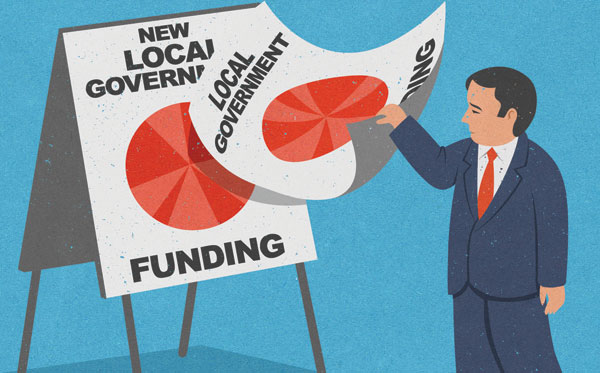By Alison Scott | 1 September 2012
Next year councils take charge of business rates and council tax support. As the levels of both are heavily dependent on changes in local economies, finance departments will have to keep one step ahead

Huge and radical change is afoot in the world of local government funding. Localisation of non-domestic rates and of support for council tax will have a profound effect on local authority finances and the level of funding risk that individual authorities will face.
Localisation of business rates is included in the Local Government Finance Bill, which is due to go to Report Stage in the House of Lords on October 10 with the aim of obtaining royal assent this year. Many of the outstanding issues were clarified in the Department for Communities and Local Government’s technical consultation document in July but some details have yet to be finalised.
The changes to Council Tax Benefit have already come into effect through the Welfare Reform Act 2012. As a result, local authorities are developing individual schemes to replace the previously centrally funded system, with a large number now out for consultation. The government has set broad criteria, most critical being the requirement that pensioners are protected from any changes. In addition, the overall funding has been cut by 10%.
Local schemes need to be approved by January 31 next year to apply for the 2013/14 financial year. If a council fails to agree a scheme, it will have to use the default one, drawn up by the DCLG and based on the previous Council Tax Benefit scheme. Given the 10% reduction in funding, failing to agree a scheme will result in an additional burden for the council.
The government is also amending the formula for calculating the local authority tax base to take account of the local schemes. Under the existing system, the tax base is unaffected by changes in Council Tax Benefit because the authority is repaid the full amount. Under the local schemes, councils will lose tax income on properties receiving the benefit. These tax falls will have to be included with existing tax reductions, such as the single person’s discount, in the calculation of the tax base.
Unlike the single person’s discount, the Council Tax Benefit amounts might not be a set percentage, and local authorities will need to make their own estimate of the total cash value of the reductions to be offered. It will be up to each billing authority to estimate the impact in their area based on the local schemes they have adopted.
If all other things remained equal, the impact of the smaller tax base would increase council tax levels across all tiers of local government. To avoid this, the government will include an allowance within the localised element of business rates for the previous costs of Council Tax Benefit, less the 10% cut. For police authorities, which will not be subject to local retention of business rates, the additional resources will be built into the police grant. How parish councils will be dealt with under the new system has yet to be determined and remains the main outstanding decision needed before implementation.
To set their tax bases, councils will need to estimate what next year’s council tax bills, and hence discounts, will be in order to forecast the total cost of discounts. If the level of claimants changes during the year, the additional cost or saving from council tax support will fall initially on the collection fund and feed through into a deficit or surplus that will be shared between the billing and precepting authorities. The actual council tax will remain fixed for the financial year.
For the localisation of business rates, the basics are clear although some of the details are still missing. It is planned that 50% of business rates will be localised through a system of top-ups and tariffs. The other 50% will be distributed via the revenue support grant, allowing local authority allocations to be scaled back year on year in line with national spending totals.
Top-ups and tariffs are set so that a local authority will start with the same resources under the new system as it would have had under the old. This fixes an index-linked amount to be paid by high-yield authorities and distributed to low-yield authorities. This gives top-up authorities a guaranteed increase in part of their resources and means that a tariff authority will lose resources unless it ensures its business rate growth keeps pace with inflation. Because of the distribution of local shares of business rates between tiers, all upper tier authorities will be top-up authorities. Police authorities are outside the scheme.
In addition to the top-ups and tariffs, there will be a levy on ‘disproportionate growth’, which will be used to provide a safety net for authorities experiencing significant falls in business rates. The top-ups and tariffs will also be reset at regular intervals. The plan is for the first one to take place in seven years to allow future resets every ten years, to fit into the Comprehensive Spending Review process. Economic Action Zones and large Tax Increment Financing schemes will be excluded from the reset mechanism and the levy.
Local authorities are free to come together to form pools for business rates purposes. In these cases, individual top-ups and tariffs will be combined as will levy arrangements. Authorities in pooling arrangements will need to agree how they will share risks and potential rewards between them.
The changes ahead will increase instability in the forecast of resources and, combined with economic uncertainty, the associated risks. For example, the decline of a major local industry could lead to both a fall in the business rate base and an increase in demand for Council Tax Benefit.
Local authorities will need to take all of this into account to estimate potential future business rates growth and demand for council tax support. Any changes during the year in the level of business rates or Council Tax Benefit will fall initially upon the collection fund. There is likely to be increased instability within the collection fund as a result of the changes and the level of surpluses and deficits is likely to rise.
Alongside the operational implementation of the new local government resource regime there will also be an impact on the way we account for non-domestic rates in particular. CIPFA is well aware of practitioners’ desire for early advice and is working on guidance for local authorities that should be available long before the system comes into operation.
There is no doubt that the new world of local government presents its challenges. But, given the huge effort from both the sector and officials within the DCLG, there is now optimism that it will also be seen as a real opportunity in the longer term to reinvigorate local government’s resource base.
Take five
The new systems will have a direct impact on resources and therefore reserves, making preparation vital. Here are five steps that every council should be taking now:
1 Understand the changes
The Local Government Finance Bill contains a huge number of proposals and the detail supporting them is still being discussed. It is essential that individual councils are aware of the implications and pace of change.
Keeping up to date involves accessing the right information from the web and having regular conversations with those around you. Virtual discussions are also highly influential, including regional and national forums. Ensure that all levels are involved and strategic discussions do not take place in isolation from the operational considerations.
2 Finance and revenue must work together
The relationship between finance officers and revenue managers will be central to the smooth running of a local authority budget. Both parties need to be aware of each other’s timescales, constraints and requirements. For example, finance will want to know the details held on business rates appeals in order to place contingencies in the budget.
The lack of local authority control around this area of budgetary responsibility will make even the most robust of accountants a little nervous.
Similarly, accountants need to explain the operational implications between the collection fund and general fund balances so that revenue officers understand the impact and timing of their decisions.
3 Exploration of options
In an era when all things are possible, option appraisal will be essential. What options are available for delivery of the scheme now, how can savings be made and how can financial risk be minimised?
Pooling provides a real opportunity, where it brings top-up and tariff authorities together to retain growth locally. But its complications should not be underestimated.
The final solutions will be as varied as the discussions taking place and will be influenced among other things by the council’s appetite for risk, the operation of the tariff or top-up and the political ambition of the leadership.
4 Modelling
As part of the options appraisal, local authorities or groups of local authorities will be coming together to look at the possible scenarios.
Modelling will be essential, allowing organisations to run various simulations of how changes in funding would affect their income.
The local information and data needed to ensure accuracy will be supplied by the organisations themselves, so consideration needs to be given to what data is available and what would be needed in the future.
Some work has already been done on what should go into a model, including a CIPFA event involving 240 delegates, but further efforts are needed in this area.
5 Forecasting
The new scheme brings not only increased opportunities for rewards but also increased financial risk should forecasts be inaccurate. Finance staff will be looking to revenues managers for confidence in the data and figures supplied.
This presents a huge challenge for the revenues team as the volatility in this area and the impact of factors beyond the control of the local authority will have implications at every stage. For example, revenues staff may have to take time to explain the relationship and role of the valuation officer so that there is clarity on the degree of accuracy that can be achieved.
Alison Scott is assistant director for local government at CIPFA. This feature first appeared in the September edition of Public Finance



















